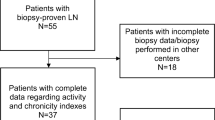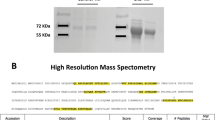Abstract
Background
Previously we found that kidney tissue and urinary exosomes from patients of diabetic kidney disease showed high levels of ceruloplasmin (CP). Because CP is an acute-phase protein of kidney origin, it could be an early marker of many other kidney diseases. To investigate this hypothesis, we first measured urine exosomal and kidney expression of CP in non-diabetic chronic kidney disease (CKD) patients (membranous nephropathy, focal segmental glomerulosclerosis, lupus nephritis and IgA nephropathy) followed by a longitudinal study in rat passive Heymann nephritis (PHN), a model of human membranous nephropathy.
Methods
Urinary exosomes were isolated from urine of patients (and rats) by differential centrifugation. The exosomal extracts were used for measuring CP using ELISA. Kidney expression of CP was evaluated by immune-staining biopsy tissues. Similar techniques were applied in rat PHN model (produced by injection of anti-gp600 antiserum) to analyze urine exosomal and kidney CP.
Results
Urine exosomal CP levels were 10–20 times higher in CKD patients than in controls; consistent with this we found high immune-reactive CP localized in tubules and collecting ducts of biopsies of CKD patients. In the PHN model urinary exosomal CP level was significantly higher prior to the onset of proteinuria. Early rise of urine exosomal CP, which preceded proteinuria, correlated with high immunoreactive CP found in rat kidneys at this time.
Conclusion
We propose that urine exosomal CP, observed to increase prior to proteinuria, makes it a potential urinary biomarker to diagnose early kidney disease.





Similar content being viewed by others
References
Pisitkun T, Shen R-F, Knepper MA. Identification and proteomic profiling of exosomes in human urine. Proc Natl Acad Sci USA. 2004;101:13368–73.
Moon P-G, You S, Lee J-E, Hwang D, Baek M-C. Urinary exosomes and proteomics. Mass Spectrom Rev. 2011;30:1185–202.
Gudehithlu KP, Garcia-Gomez I, Vernik J, Brecklin C, Kraus M, Cimbaluk DJ, Hart P, Dunea G, Arruda JAL, Singh AK. In diabetic kidney disease urinary exosomes better represent kidney specific protein alterations than whole urine. Am J Nephrol. 2015;42:418–24.
Chun-Yan L, Zi-Yi Z, Tian-Lin Y, Yi-Li W, Bao L, Jiao L, Wei-Jun D. Liquid biopsy biomarkers of renal interstitial fibrosis based on urinary exosomes. Exp Mol Pathol. 2018;105:223–8.
Makker SP, Singh AK. Characterization of the antigen gp600 of Heymann Nephritis. Lab Invest. 1984;30:287–96.
Berradi H, Bertho J-M, Dudoignon N, Mazur A, Grandcolas L, Baudelin C, Grison S, Voisin P, Gourmelon P, Dublineau I. Renal anemia induced by chronic ingestion of depleted uranium in rats. Toxicol Sci. 2008;103:397–408.
Huang Q, Dunn RT, Jayadev S, DiSorbo O, Pack FD, Farr SB, Stoll RE, Blanchard KT. Assessment of cisplatin-induced nephrotoxicity by microarray technology. Toxicol Sci. 2001;63:196–207.
Kondo C, Minowa Y, Uehara T, Okuno Y, Nakatsu N, Ono A, Maruyama T, Kato I, Yamate J, Yamada H, Ohno Y, Urushidani T. Identification of genomic biomarkers for concurrent diagnosis of drug-induced renal tubular injury using a large-scale toxicogenomics database. Toxicology. 2009;265:15–26.
Luhe A, Hildebrand H, Bach U, Dingermann T, Ahr H-J. A new approach to studying ochratoxin A (OTA)-induced nephrotoxicity: expression profiling in vivo and in vitro employing cDNA microarrays. Toxicol Sci. 2003;73:315–28.
Moon PG, Lee J-E, You S, Kim T-K, Cho J-H, Kim I-S, Kwon T-H, Kim C-D, Park S-H, Hwang D, Kim Y-L, Baek M-C. Proteomic analysis of urinary exosomes from patients of early IgA nephropathy and thin basement membrane nephropathy. Proteomics. 2011;11:2459–75.
Osaki S, Johnson DA, Frieden E. The possible significance of the ferrous oxidase activity of ceruloplasmin in normal human serum. J Biol Sci. 1966;241:2746–51.
Morita H, Ikeda S-I, Yamamoto K, Morita S, Yoshida K, Nomoto S, Kato M, Yanagisawa N. Hereditary ceruloplasmin deficiency with hemosiderosis: a clinicopathological study of a Japanese family. Ann Neurol. 1995;37:646–56.
Hellman NE, Gitlin JD. Ceruloplasmin metabolism and function. Annu Rev Nutr. 2002;22:439–58.
Patel BN, David S. A novel glycosylphosphatidylinositol-anchored form of ceruloplasmin is expressed by mammalian astrocytes. J Biol Chem. 1997;272:20185–90.
Jeong SY, David S. Glycosylphosphatidylinositol-anchored ceruloplasmin is required for iron efflux from cells in the central nervous system. J Biol Chem. 2003;278:27144–8.
Acknowledgements
The authors thank Dr. Lev Rappoport and Ms. Anu Hakimiyan for help with the histologic processing of tissue. This work was financially supported by Hektoen Institute for Medicine, Chicago IL (1994–present).
Author information
Authors and Affiliations
Corresponding author
Ethics declarations
Conflict of interest
None declared.
Human subjects ethical approval
The study was approved and conducted according to the ethical standards of the Institutional Review Board of John H. Stroger, Jr. Hospital of Cook County, Chicago IL, and with the 1964 Helsinki declaration and its later amendments or comparable ethical standards. The IRB approval and the informed patients consent forms are approved by the Institutional Review Board (IRB approved #: 11-210).
Animal ethical approval
All experimental procedures performed in studies involving animals were in accordance with the ethical standards of the Institutional Animal Care Committee of John H. Stroger, Jr. Hospital of Cook County, Chicago IL (IUCAC #: HEK-0018-2015).
Additional information
Publisher's Note
Springer Nature remains neutral with regard to jurisdictional claims in published maps and institutional affiliations.
Electronic supplementary material
Below is the link to the electronic supplementary material.
About this article
Cite this article
Gudehithlu, K.P., Hart, P., Joshi, A. et al. Urine exosomal ceruloplasmin: a potential early biomarker of underlying kidney disease. Clin Exp Nephrol 23, 1013–1021 (2019). https://doi.org/10.1007/s10157-019-01734-5
Received:
Accepted:
Published:
Issue Date:
DOI: https://doi.org/10.1007/s10157-019-01734-5




